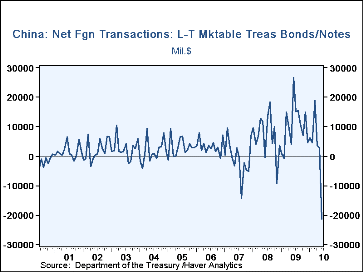 Global| Aug 16 2010
Global| Aug 16 2010Foreign Investors Increase Net Purchases of U.S. Securities in June, But Amount Is Restrained
Summary
Foreign participation in U.S. capital markets was relatively modest in June, according to the monthly "TIC" data reported this morning from the U.S. Treasury. Foreign investors were net purchasers of $33.9 billion in long-term [...]
Foreign participation in U.S. capital markets was relatively modest in June, according to the monthly "TIC" data reported this morning from the U.S. Treasury. Foreign investors were net purchasers of $33.9 billion in long-term domestic securities, up marginally from May, but much less than March and April’s amounts that each exceeded $100 billion. Net purchases of Treasuries in June were $33.2 billion and of federal agency debt, $18.2 billion; foreigners were net sellers of corporate bonds, $13.5 billion, and equities, $4.1 billion. On the other side of these accounts, U.S. investors sold $10.4 billion of foreign securities back to foreign holders, up from a mere $2.4 billion in May and the reverse of net purchases the two months before. Including swap-related transactions and activity in nonmarketable Treasuries, foreign investors made net purchases of $23.5 billion in long-term securities in June, again, up from May, but less than earlier in the year.
Perhaps the more interesting developments come in the flows by country. Chinese investors, for example, were net sellers of U.S. securities in June, by $15.0 billion in total, with $21.2 billion in Treasuries; they bought $5.5 billion in federal agencies and had small net changes in corporate securities. This was the first month since February 2009 when they were net sellers and it was the largest net sales amount on record. Japanese, in contrast, bought $27.7 billion in U.S. securities, including net purchases of all major types of debt and equity; this is among the larger amounts the Japanese have bought in any given month, although it more possibly highlights that they are active traders and move significant amounts in both directions. In looking at the Chinese data, we also note that China’s trade balance has been smaller in most recent months than it had run the prior few years, and their fragmentary balance of payments data so far in 2010 indicates an overall reduced volume of net portfolio investment abroad.
The TIC data are found in Haver’s USINT database. The information there also includes aggregate flows in Treasury bills and other short-term assets as well as banking system data on claims on and liabilities to foreign counterparties.
| Net Purchases of Long-Term U.S. Securities (Bil.$) | June | May | April | June 2009 | Monthly Average | ||
|---|---|---|---|---|---|---|---|
| 2009 | 2008 | 2007 | |||||
| Total | 33.9 | 32.9 | 110.3 | 125.4 | 53.3 | 34.6 | 83.8 |
| Treasuries | 33.3 | 14.9 | 76.4 | 100.5 | 44.9 | 26.2 | 16.5 |
| China | -15.0 | 9.2 | 6.2 | 26.1 | 8.2 | 10.9 | 9.2 |
Carol Stone, CBE
AuthorMore in Author Profile »Carol Stone, CBE came to Haver Analytics in 2003 following more than 35 years as a financial market economist at major Wall Street financial institutions, most especially Merrill Lynch and Nomura Securities. She has broad experience in analysis and forecasting of flow-of-funds accounts, the federal budget and Federal Reserve operations. At Nomura Securites, among other duties, she developed various indicator forecasting tools and edited a daily global publication produced in London and New York for readers in Tokyo. At Haver Analytics, Carol is a member of the Research Department, aiding database managers with research and documentation efforts, as well as posting commentary on select economic reports. In addition, she conducts Ways-of-the-World, a blog on economic issues for an Episcopal-Church-affiliated website, The Geranium Farm. During her career, Carol served as an officer of the Money Marketeers and the Downtown Economists Club. She has a PhD from NYU's Stern School of Business. She lives in Brooklyn, New York, and has a weekend home on Long Island.







